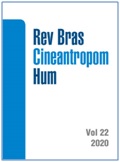Judo performance: kinanthropometric importance for technical tactical and biomechanics
DOI:
https://doi.org/10.1590/1980-0037.2020v22e76584Resumen
In such a competitive combat sport as judo, it is important that the training is carefully planned so that the athlete can stand out in the international competition. In this context, it is important that the trainer and evaluator are accurate regarding the measures taken of the athlete. Such measures, when correctly performed, can prepare the trainer with tools that allow prescribing contextualized training. The present point of view will show how kinanthropometric variables can be considered by coaches and evaluators when performing technical-tactical and biomechanical analysis in judo athletes. There are differences between sex and weight divisions as to the actions that are prevalent in each one of the categories. Lighter divisions performances must have specific training regarding approach and gripping. Attention should be paid to anticipation in athletes of the light and middle divisions. The rating of force development is the most important biomechanical measure.
Citas
Dal Bello F, Aedo-Muñoz E, Brito CJ, Miarka B. Performance analysis and probabilities by gender in judo: combat phases, techniques and biomechanical levers. Facta Univ Phys Educ Sports 2019;17(1):135-48.
Miarka B, Brito CJ, Amtmann J, Cordova C, Bello FD, Camey S. Suggestions for Judo Training with Pacing Strategy and Decision Making by Judo Championship Phases. J Hum Kinet. 2018;64:219-32.
Ishii T, Ae M, Suzuki Y, Kobayashi Y. Kinematic comparison of the seoi-nage judo technique between elite and college athletes. Sports Biomech. 2018;17(2):238-50.
Miarka B, Sterkowicz-Przybycien K, Fukuda DH. Evaluation of Sex-Specific Movement Patterns in Judo Using Probabilistic Neural Networks. Motor Control. 2017;21(4):390-412.
López Díaz-de-Durana A, Bello Fd, Brito CJ, Miarka B. High level performance in world judo circuit: Notational analyzes of combat phase by weight categories. J Human Sport Exerc. 2018;13(PROC2):S329-S38.
Sterkowicz-Przybycien K, Miarka B, Fukuda DH. Sex and Weight Category Differences in Time-Motion Analysis of Elite Judo Athletes: Implications for Assessment and Training. J Strength Cond Res. 2017;31(3):817-25.
Brito CJ, Miarka B, de Durana ALD, Fukuda DH. Home Advantage in Judo: Analysis by the Combat Phase, Penalties and the Type of Attack. J Hum Kinet. 2017;57:213-20.
Zaggelidis G, Lazaridis S. Muscle activation profiles of lower extremities in different throwing techniques and in jumping performance in elite and novice greek judo athletes. J Hum Kinet. 2013;37(1):63-70.
Pedraza Mejías C, Martínez Cañadas J. Physiological response of the muscular and tendinous conjunctive tissue after application of physical agents. Fisioterapia. 2008;30(6):279-85.
Monteiro LF, Massuça LM, García JG, Carratala V, Proença J. Plyometric muscular action tests in judo-and non-judo athletes. Isokinet Exerc Sci. 2011;19(4):287-93.
McLellan CP, Lovell DI, Gass GC. The role of rate of force development on vertical jump performance. J Strength Cond Res. 2011;25(2):379-85.
Trevino MA, Herda TJ. The effects of training status and muscle action on muscle activation of the vastus lateralis. Acta Bioeng Biomech. 2015;17(4):107-14.
Besomi M, Hodges PW, Clancy EA, Van Dieën J, Hug F, Lowery M, et al. Consensus for experimental design in electromyography (CEDE) project: Amplitude normalization matrix. J Electromyogr Kinesiol. 2020:102438.
Sterkowicz S, Lech G, Sterkowicz-Przybycień K, Chwała W, Ambroży T, Pałka T. Relationship of maximal isometric torque produced in flexors and extensors rate to technique by judo athletes. Acta Bioeng Biomech. 2018;20(2).
Aedo-Muñoz E, Araya-Ibacache M, Miarka B, Moya-Jofre C, Cancino-López J, Mozer RL, et al. Effect of sex differences in sports groups on hamstring flexibility based on the sitreach test: new parameters for Chilean athletes. J Phys Ed Sport. 2019;19(4):2374-8.
Descargas
Publicado
Número
Sección
Licencia

Direitos Autorais para artigos publicados nesta revista são do autor, com direitos de primeira publicação para a revista. Em virtude da aparecerem nesta revista de acesso público, os artigos são de uso gratuito, com atribuições próprias, em aplicações educacionais e não-comerciais, desde que seja dada a atribuição. Esta obra foi licenciada com uma Licença Creative Commons Atribuição 4.0 Internacional - CC BY


